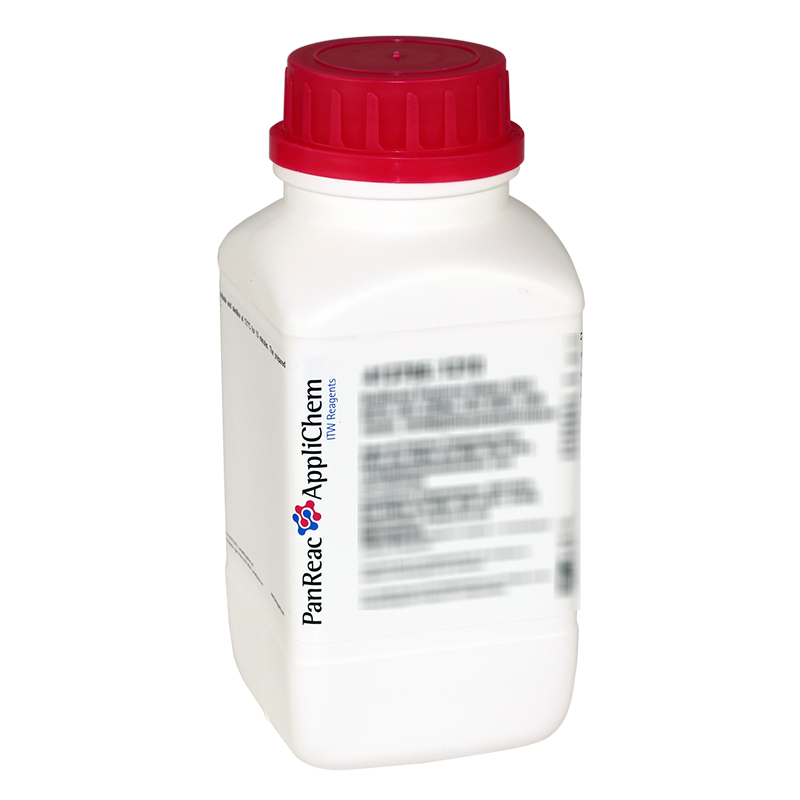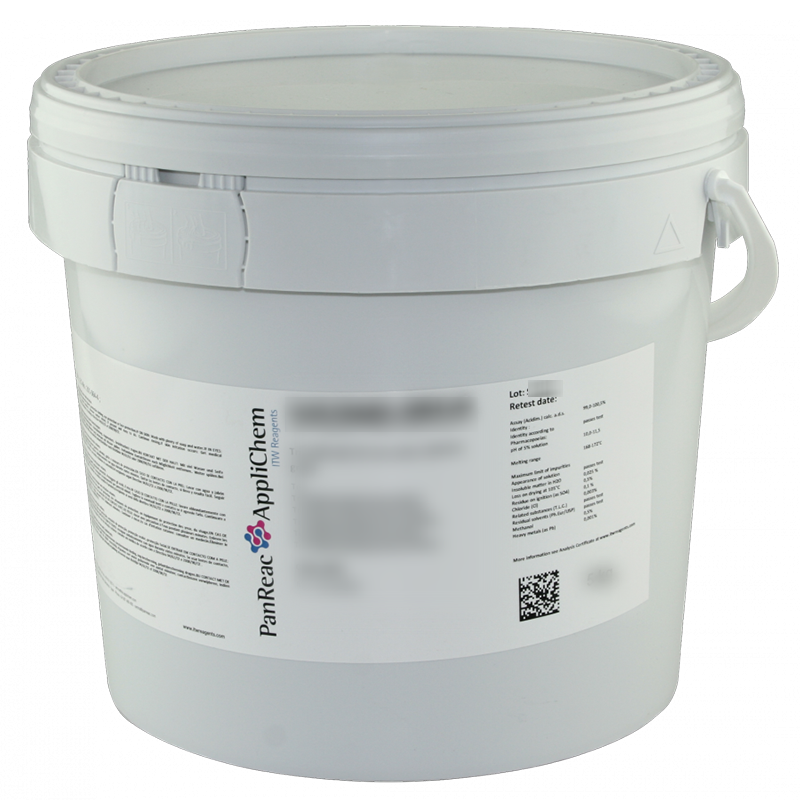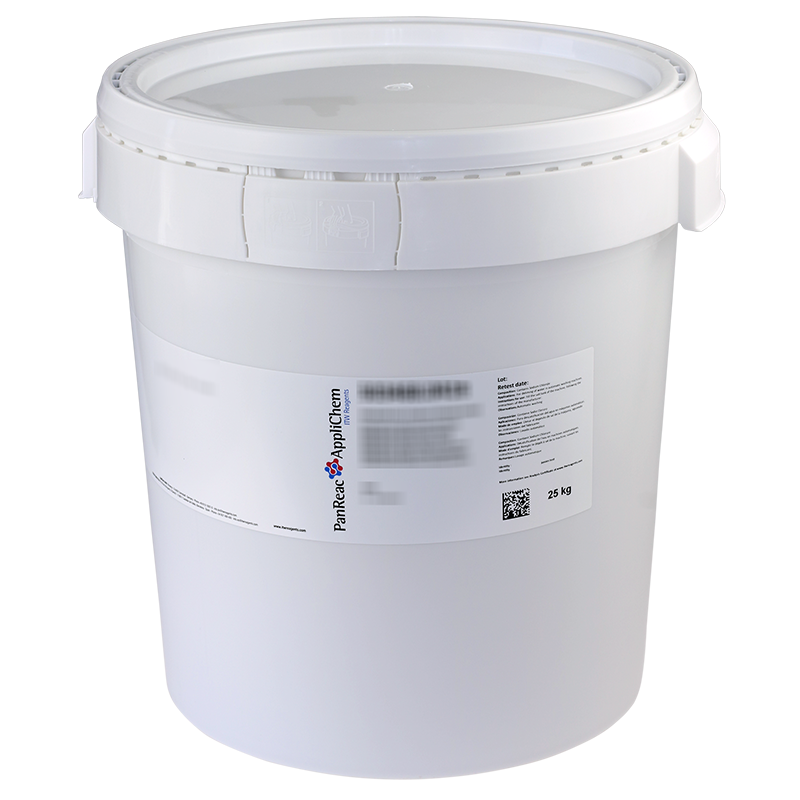Packs sizes (3)
| code | packaging size | price per unit | box price per unit | |
|---|---|---|---|---|
| Code & packaging | Price per piece | |||

|
code
171659.1211
|
packaging size
1000 g
|
price per unit
single
$42,60
|
box price per unit
$36,21x 6 units
|

|
code
171659.0415
|
packaging size
10 kg
|
price per unit
single
$280,95
|
box price per unit
|

|
code
171659.0416
|
packaging size
25 kg
|
price per unit
single
$673,20
|
box price per unit
|
Technical data
- Melting Point:
- 804 °C
- Boiling Point:
- 1,413 °C
- Solubility:
- water 360 g/l at 20 °C
- Physical Description:
- solid
- Product Code:
- 171659
- Product Name:
- Sodium Chloride ASTM B117, ISO 9227
- Headline Comment:
- for saline spray (fog)
- Specifications:
- Minimum assay (Arg.): 99.7%
Maximum limit of impurities
Anti-caking Agents: 0.0%
Sodium Iodide (NaI): 0.1%
Halides (Bromide, Fluoride, Iodide): 0.1%
Total impurities: 0.2%
Cu: 0,00003 %
Ni: 0,001 %
Pb: 0,0025 %
According to ASTM B117-19 and ISO 9227-17
- WGK:
- nwg
- Storage:
- Room Temperature.
- Master Name:
- Sodium Chloride
- EINECS:
- 231-598-3
- CS:
- 2501 00 99 00
Documents
Inquiry
Comments
Sodium chlorideSodium chloride (also called table salt) is the sodium salt of hydrochloric acid with the chemical formula NaCl - not to be confused with sodium chlorite (NaClO2), the sodium salt of chlorous acid.
Sodium chloride is the most important mineral for humans and animals. The body of an adult human contains about 150-300 grams of common salt and loses 3-20 grams of it every day, which must be replaced. It was extracted for this purpose in prehistoric times and remained an expensive commodity for a long time.
Occurrence
Sodium chloride is present in nature in large quantities, mostly dissolved in sea water with a content of about 3%, a total of 3.6 * 1016 tons, and also as the mineral halite with a content of up to 98% in the frequent rock salt deposits, which sedimented in drying sea bays in earth-historical times. The total volume of deposits occurring under Germany is estimated at 100,000 cubic kilometers.
Rock salt layers are plastic and are therefore deformed many times by geological processes to which they are subject, including to form salt domes and salt pillows that are easier to mine. When a salt deposit in the mountains escapes to the surface, it can even form a salt glacier.
Extraction
Sodium chloride is extracted on a large scale from the two main deposits, rock salt and sea salt. Salt from surface deposits, e.g. salt lakes, is of only minor importance. World salt production in 2006 was over 250 million tons, with the shares of rock salt and sea salt estimated at about 70% and 30%, respectively. China increased its production considerably in recent years, while the USA still had the largest production until 2005. Overall, the EU produces similar quantities to the USA.
In salt mines, among which open-pit mines are of minor importance today in quantitative terms, rock salt is mined either by drilling-blasting, cutting or wet mining. In the first two cases, the material, which is still crushed underground with crushers, is brought to the surface in various grain sizes. In the case of wet mining, as in the case of borehole brining operated exclusively from above ground, the salt is dissolved in water by means of drilling mud plants, historically also in sinking plants, and brought to the surface as saturated brine of 26.5%. This also allows the utilization of heavily contaminated deposits. When water passes naturally through salt-bearing strata, brine can also come to the surface, but it is usually not saturated. Such brine springs were the first inland salt deposits exploited by man. In the past, the concentration of brine was increased by evaporation of water in graduation works; today, dry mined salt is added. From the purified brine, evaporated salt of high purity is produced. Today, this is done by means of closed vacuum evaporators arranged in cascades, whereby a large part of the heat used is recovered. In climatically suitable areas, solar energy is also increasingly being used for evaporation; the process is similar to that used for sea salt extraction.
The extraction of salt from seawater is only economically viable in coastal areas with high solar radiation and low precipitation. For this purpose, the seawater is led through shallow basin cascades (salt marshes), in which the salt concentration increases by natural evaporation. Finally, the precipitated salt is pushed together and dried; only for the expensive table salt quality (French fleur de sel, "flower of salt") is it skimmed off floating on the surface. Brine can also be extracted from salt marshes.
The four basic products of the salt industry are brine, rock salt, sea salt and evaporated salt. For the U.S., the U.S. Geological Survey estimated 2007 ex-factory median prices of $10/ton for brine, $25/ton for rock salt, $57/ton for salt from solar evaporation, and $150/ton for evaporated salt.
Properties
Sodium chloride forms colorless crystals that form a cubic sodium chloride structure. Unlike many other crystals, they are not birefringent. Here, each sodium as well as each chlorine nucleus is octahedrally surrounded by the other nucleus. A hexagonal structure can be produced in a thin layer on a diamond surface. It is very soluble in water, the solubility being only slightly dependent on temperature. According to Raoult's law, there is a decrease in vapor pressure in aqueous solutions compared to pure water. The effect increases with rising sodium chloride concentration or temperature. The saturated solution boils at 108.7 °C.
At a content of 23.4% sodium chloride in aqueous solution, it forms a eutectic mixture. This solidifies homogeneously at the eutectic point of -21.3 °C without segregation. This solution is called cryohydrate. Below 0.15 °C, a stable dihydrate NaCl * 2 H2O is formed. The salt dissolves very well in aqueous ammonia solution. At lower temperatures, a pentaammonia solvate NaCl * 5 NH3 may precipitate in the form of colorless needles. Addition compounds with urea, glucose and sucrose are also known.
The aqueous solution as well as the melt conduct electric current due to the (electrolytic or thermal) dissociation of sodium chloride into its ions. The conductivity of the melt increases with temperature. Pure crystalline sodium chloride, on the other hand, is practically non-conductive.
Use
Table salt
As table salt, sodium chloride is an important component of the human diet. It is used to season almost all foods. Since the time of industrialization, however, industrial use has played by far the greater role in terms of quantity. Depending on the application, different additives are added.
According to use, a distinction is made between salt for chemical use as a raw material for the chemical industry, de-icing salt for winter road maintenance, industrial salt for a wide variety of industrial and commercial purposes, and table salt for human consumption.
Salt for chemical use
The term salt for chemical use refers only to the sodium chloride used in the basic chemical industry. It consists of rock salt, and in the case of corresponding local market conditions, such as in India, also sea salt, as well as brine on a large scale, some of which is transported in pipelines. For the USA, the brine content is given as 90%. It is a versatile raw material for the chemical industry and the basis for many products. The production to important basic materials essentially starts with two different processes:
- Chlor-alkali electrolysis with the products hydrogen, chlorine and caustic soda, which are further processed by chlorine chemistry on the one hand, and by using the sodium hydroxide on the other.
- Solvay process with the products sodium carbonate (soda) and sodium hydrogen carbonate (soda). Soda ash is required, among other things, in the melting of quartz sand as a glass raw material and for the production of dyes and detergents and cleaning agents. Sodium bicarbonate is used as a baking and fire extinguishing powder, in medicines and as a feed additive.
- Other important downstream products include plastics, medical preparations and pesticides.
De-icing salt
Rock salt is used in winter at moderate freezing temperatures as de-icing salt (road salt), sometimes with additives to maintain its pourability. In Germany, de-icing salt was dyed to prevent its use in food preparation. However, this became obsolete when the salt tax was abolished on January 1, 1993. Brine is also added before spreading to produce more suitable pre-wetted salt.
Industrial salt
Industrial salt is practically all salt used commercially, technically or industrially that does not fall into one of the other three categories. Salt for the purpose of food preservation, although consumed in small quantities, counts as industrial salt. The spectrum of industrial salt is therefore very wide, ranging from coarse unpurified rock salt to highly purified sodium chloride and sterile preparations for chemical, pharmaceutical and medical purposes. Depending on the use, a wide variety of additives are also added.
Livestock
Livestock salt is added to the feed of livestock such as cattle, sheep and goats (unpurified, denatured rock salt, with other mineral salts added if necessary). This increases their appetite and contributes to overall health. - Salt licks are also known to be used in zoological gardens, livestock, pets and wildlife.
Preservation
Salt is traditionally used for the preservation of foods such as meat (pickling, suricings), fish (such as salted herring), vegetables (sauerkraut), and so on. In this process, the salt removes moisture from the goods by osmotic action. Thus, the basis water for harmful organisms is withdrawn, but also germs and pathogens are killed.
Nitrite pickling salt consists of a mixture of table salt and sodium nitrate, sodium nitrite or potassium nitrate.
Pickling vegetables (such as pickled cucumbers, olives) in brine takes advantage of the germicidal effect.
Cheese is prepared in salt water before ripening and maintained with brine during ripening to keep the crust dry.
Physical/chemical applications
Salt is used as a regenerating salt for water softening in dishwashers and water treatment plants. It is added to water in refrigeration mixtures.
Salt is also an indispensable raw material in leather processing and dyeing.
In the manufacture of tableware and other ceramics, the traditional salt glaze is produced by adding moist salt at high temperature. In this process, the sodium ion of the common salt dissociated in the kiln atmosphere combines with the silicates of the clay to form a durable glaze. However, the salt is aggressive at the application temperatures (1,200 °C and higher) and damages the interior of the kiln (the fire-side thermal insulation), which must therefore be replaced more frequently.
The ionizing effect of the salt is used in metal processing.
Medicine
In modern medicine, a 0.9% solution of sodium chloride in water (isotonic saline) is used as a carrier solution for medicines.
In ancient times and in the Middle Ages, salt-based medicines were considered effective remedies. The skin of newborns was rubbed with salt to strengthen it. It was used in wound dressings, plasters, ointments, powders and baths. Special importance was attached to the drying and warming effect of salt.
In the Middle Ages, salt was also used for the external treatment of ulcers and wounds, as it was considered to be astringent, cleansing and soothing.
Salt was sprinkled into wounds to prevent inflammation - a sometimes very painful procedure that has found its way into the German language in a corresponding idiom ("sprinkle salt into open wounds"). Pure salt destroys all cells via osmosis - including pathogenic microorganisms such as bacteria and fungi, but also the cells of the wounded person. This kind of disinfection is therefore double-edged like the equally practiced cauterization of wounds. The same mechanism of action prevented food preserved in common salt from spoiling - that is, from being decomposed by microorganisms.
Even today, brine baths are used as a remedy. Spa stays at the seaside or in salty air at salt works and, in earlier times, in salt mines are used to treat respiratory diseases. Where this is not possible or too expensive, inhalation devices are used in which salt aerosol is inhaled. - Saline is also used for nasal irrigation and gargling. For nasal irrigation, isotonic saline is used because normal water would swell the mucous membranes due to osmosis.
Infrared optics
Crystalline sodium chloride is sufficiently transparent to light with wavelengths between 0.21 and 25 µm to be used for optical elements. Sodium chloride is therefore used to make lenses, prisms and windows suitable for the visible range as well as in the near to mid-infrared. Due to the water solubility of sodium chloride, optical elements made of this material are damaged by atmospheric moisture. However, this can be prevented if their temperature is kept above the ambient temperature. For this reason, heaters are often integrated into the mounts used. Sodium chloride windows are often used as Brewster windows for high-power pulsed CO2 lasers, but also in other fields. In infrared spectroscopy, it is pressed into tablets as a carrier for test samples.
Chemical analysis
Sodium chloride is the original titrant according to the pharmacopoeia for the adjustment of silver nitrate measuring solutions. To prepare a measured solution with sodium chloride, it must first be dried.
Table salt
Table salt is essential for human life (see physiological significance). In the past, table salt was very precious. It simplifies the preparation of food and improves its taste by acting as a seasoning. The lethal dose, which leads to hypernatremia, is given as 0.5 to 5 grams per kilogram of body weight in adults.
Today, commercially available salt is often iodized, i.e. added with food-grade iodine compounds, and is intended to prevent possible iodine deficiency. In the trade, it is referred to as iodized salt. In addition, table salt crystals are usually coated with a separating agent to maintain their pourability.
Products with added sodium fluoride (to improve dental health) and folic acid are also on the market.



